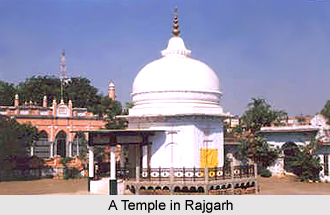 History of Rajgarh district deals with the rule of Mughal kings and the native princes from 1681. Before this, the area of the present Rajgarh district was parcelled out among the princely state of Rajgarh, Khilchipur, Narsinghgarh, Dewas district (Senior), Dewas (Junior) and Indore.
History of Rajgarh district deals with the rule of Mughal kings and the native princes from 1681. Before this, the area of the present Rajgarh district was parcelled out among the princely state of Rajgarh, Khilchipur, Narsinghgarh, Dewas district (Senior), Dewas (Junior) and Indore.
The Umat Rajputs, the branch of the great Paramara Dynasty ruled the Rajgarh District. They enjoyed a "Sanad" Estate (a legal document approved to the princely states confirming them in their states, in return for their loyalty) under the Sultans of Delhi and Mughal Emperors in succession. The first capital of Rajgarh District was Duparia, now in Shajapur District. Later, the capital was shifted to Dungarpur, which is 19 kilometres from Rajgarh, and then to Ratanpur, which is 19 kilometres to the west of Narsinghgarh. In order to avoid disturbance by the frequently passing Mughal armies, the ruler of the Estate, Mohan Singh, acquired the present side, originally known as Jhanjhanipur from the Bhil Tribe in the year 1640. Finally, he shifted the headquarters in the year 1645, giving the place its present name. The district got its name from the headquarters town Rajgarh.
During the reign of the Mughal Emperor, Akbar (1556-1605), a "Khilat" and a Sanad were granted to Udaji of Tatanpur. During that period, Sarangpur was a Sarkar in the Subah of Malwa. Its jurisdiction extended from the western part of present Sehore district to the eastern regions of Ujjain district. Among its 24 Mahals, many have retained their original names and are identified as Ashtah, Agra (Agar), Bajilpur (Bijilpur), Talain (Talen), Bhorsah, Khiljipur, Sarangpur, Jirapur, Sondarsi (Sundarsi), Sajapur, Sosner (Sunner), Kayath and Navgam (Tarana).
In the year 1645, with the permission of Rajmata, Deewan Ajab Singh defeated the Bhils in the hilly region of Rajgarh and constructed a Palace in the year 1745, which was having 5 main gates namely, Itwaria, Surajpol, Bhudwaria, Panradia and Naya Darwaja. In addition, it constitutes three very ancient temples namely Raj Rajeshwar temple, Chatubhujnathji temple and Narsingha temple. In Jhanjherpur, which was the capital and it is having a palace due to which this place is known as Rajgarh and it had become famous. At present, the district is divided into 5 subdivisions and 6 tehsils.
In the year 1908 that is during the rule of British Government, Rajgarh state was divided into 7 Parganas, namely Biaora, Newalganj, Karanwas, Kotra, Kalipith, Talen and Seogarh. The Princely State of Narsinghgarh was divided into 4 Parganas, namely Huzur (Narsinghgarh), Khujner, Pachore and Chhapra. The Parganas were place in the charge of a Tahsildar each for revenue matters and magisterial work. The Princely State of Khilchipur was divided into 3 Paraganas. Sarangpur was the tahsil headquarters of Dewas District. Jarapur was a tahsil of Mahidpur district of former Indore State.



















